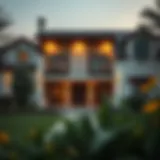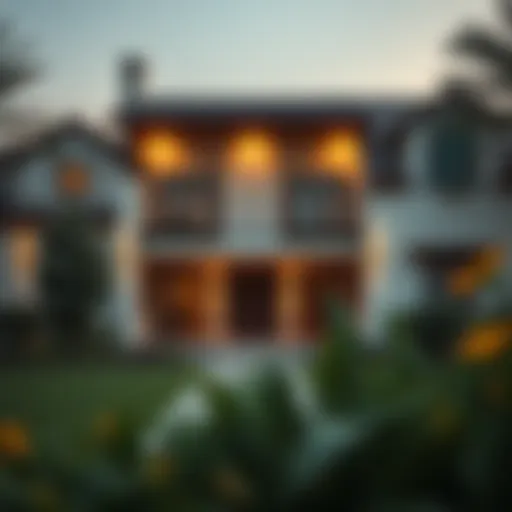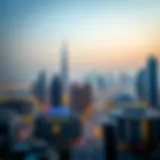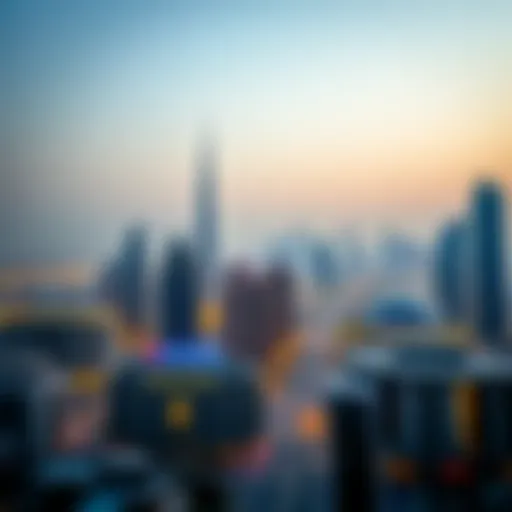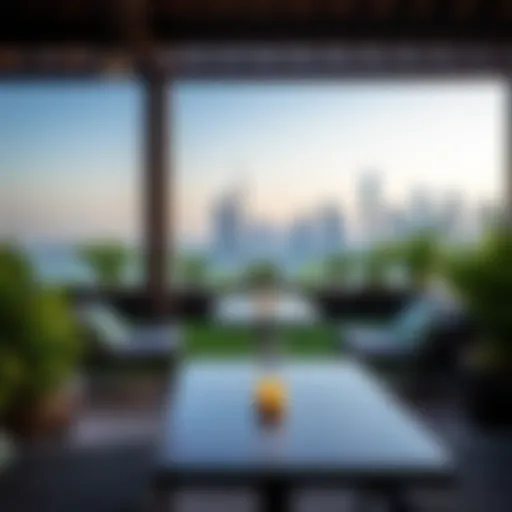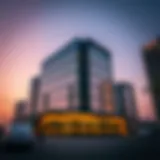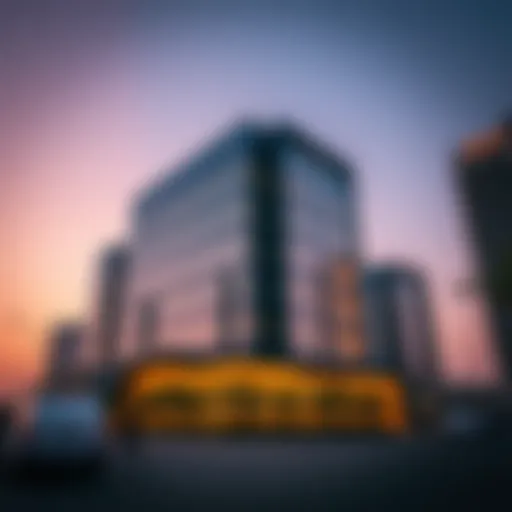Exploring Burj Khalifa Park: Landscape and Significance
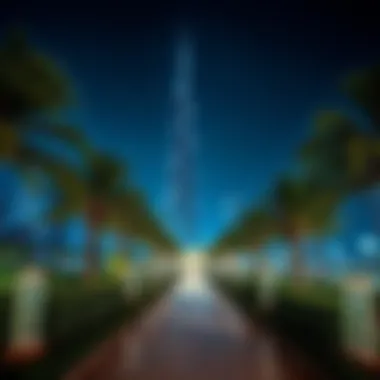

Intro
Burj Khalifa Park stands as a shining emblem of urban sophistication in the heart of Dubai. This green sanctuary, tucked at the foot of the world’s tallest building, offers more than just a lush escape from the bustling city. With its thoughtfully designed landscapes and several recreational amenities, the park serves not only as a picturesque locale but also plays a pivotal role in shaping the urban environment around it.
A visit to Burj Khalifa Park unveils a complex interplay between modern architecture and nature, inviting visitors to relish tranquility against the backdrop of the towering skyline. It is a space where families picnic on manicured lawns, joggers make their rounds along winding paths, and art enthusiasts marvel at sculptures interspersed throughout the park.
This article aims to traverse the many layers of Burj Khalifa Park, examining its architectural layout, ecological balance, and cultural significance. We’ll take a look at how this urban oasis enhances the overall aesthetic of its surroundings, and what it means for residents and investors alike.
Prelude to Burj Khalifa Park
Burj Khalifa Park stands as a testament to the harmonious blend of nature and urban life in the heart of Dubai. Its significance extends beyond mere aesthetics; rather, it serves as a vital artery in the bustling landscape of the city. While the towering Burj Khalifa captivates the eyes, the park offers a serene contrast, inviting residents and tourists alike to pause and appreciate the splendid surroundings.
Nestled amidst skyscrapers, the park provides an oasis of greenery, promoting both environmental sustainability and an enhanced quality of life. Those who find themselves wandering through its pathways are often struck by the park's ability to evoke a sense of tranquility amidst the metropolitan hustle. This dual nature — a leisure haven paired with a backdrop of dazzling architecture — makes it not only a center for relaxation but also for cultural exchange.
Exploring Burj Khalifa Park goes hand in hand with understanding its landscape. This park isn’t just a patch of grass; it is an intricate tapestry of design, flora, and community interaction. For investors and realtors, the park’s role in enhancing property values in the surrounding area is noteworthy and factors heavily into real estate decisions.
It's crucial to appreciate the careful planning and implementation that went into creating this urban retreat. Every tree, flowerbed, and walkway has been selected and crafted to foster both ecological balance and aesthetic pleasure. By the end of this article, readers will have a thorough grasp of the park's importance in Dubai's overall cultural and ecological tapestry, benefiting families, business owners, and investors alike.
Location and Overview
Burj Khalifa Park encompasses approximately 11 hectares and is situated in Downtown Dubai, not far from the world-renowned Dubai Mall. Its strategic location makes it accessible from various vantage points in the city, and the backdrop of the Burj Khalifa only amplifies its allure. The park features landscaped gardens, decorative fountains, and pathways, which align beautifully with the sleek lines of the surrounding skyscrapers.
Visitors can easily navigate to the park via the Dubai Metro, thanks to its proximity to the Burj Khalifa/Dubai Mall station. This ease of access attracts both local residents and international tourists, further solidifying the park's significance as a communal hub in this expansive urban environment.
Historical Context
The concept of Burj Khalifa Park began to take shape alongside the vision for the Burj Khalifa itself, which was completed in 2010. The park is part of a larger development strategy that aimed to transform Dubai into a global center for trade, tourism, and culture. Built around the world’s tallest building, the park was designed as a recreational area that would enhance not only the aesthetics of the area but also serve functional purposes like community gatherings and events.
The architectural ambition of the Burj Khalifa spurred an equal commitment to the landscaping of the area surrounding it. Dubai’s leadership envisioned a greener metropolis, and the park's development was a crucial step in realizing that goal. Over the years, Burj Khalifa Park has evolved with the city, adapting to its growth while maintaining a commitment to environmental sustainability. Through a careful selection of native plants and environmentally-friendly practices, the park stands as an example of how urban spaces can coexist harmoniously with nature.
Architectural Features
Burj Khalifa Park is an exemplar of modern urban planning, where landscape and architecture meld seamlessly to create an inviting environment. The architectural features of the park not only serve aesthetic purposes but also align with functional considerations that impact visitor experience and ecological sustainability. Every inch of the park has been thoughtfully designed to harmonize with the surrounding elements of Dubai, especially the iconic Burj Khalifa itself.
Design Elements
The park's design elements embody innovation, balancing beauty and utility. Walking through the park, you will notice winding pathways flanked by lush greenery and various seating areas. These paths are designed not merely for navigation but to invite exploration.
Consider the use of materials; natural stones and modern pavement techniques are employed to promote sustainability while ensuring durability. The blend of geometry is also noteworthy. The circular and rectangular shapes create clear zones that guide visitor movement, while allowing spaces for social interaction and relaxation. This interplay of shapes fosters a sense of balance in the park, reinforcing its connection to the Burj Khalifa standing tall above.
Moreover, water features interspersed throughout the park provide an additional layer of sensory appeal—sounds of flowing water add tranquility and create a cooling effect in Dubai's hot climate. The careful positioning of these features enhances the overall ambiance, turning the park into an oasis amidst the urban sprawl.
Art Installations
Art installations in Burj Khalifa Park serve double duty: enhancing the cultural landscape and offering reflective spaces for visitors. Each art piece is meticulously curated to provoke thought while connecting art with the surrounding nature. One notable installation is the towering sculptures symbolizing unity and collaboration—a nod to Dubai's multicultural tapestry.
Visitors often find themselves captivated by these installations, prompting conversations about culture and identity. The placement of each piece is strategic, often linking the artwork with elements of the natural landscape. For example, a sculpture may be framed by palm trees, creating a picturesque view that serves both as a backdrop for photographs and a moment for contemplation.
A further benefit of these installations is their ability to draw in crowds for community events, making them pivotal in fostering a sense of belonging among diverse groups. Art within the park promotes inclusivity, echoing Dubai's ethos as a global hub.
The blend of nature, architecture, and art in Burj Khalifa Park cultivates a unique sense of place, inviting residents and tourists alike to engage with their environment.
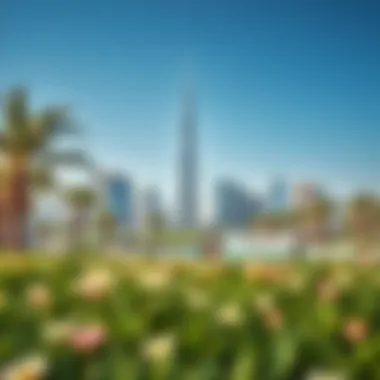

In summation, the architectural features of Burj Khalifa Park manifest a commitment to both beauty and function. These elements not only elevate the visitor experience but contribute significantly to the park’s role as a landmark in Dubai. The artistic and design choices resonate deeply with the culture and community values, marking the park as a vital part of the city's identity.
Landscaping and Flora
The significance of landscaping and flora at Burj Khalifa Park extends beyond mere aesthetics; it serves as a vital component in creating an inviting atmosphere in the heart of Dubai's bustling landscape. Thoughtfully designed landscapes can provide a sanctuary for city dwellers and tourists alike. This pocket of green not only brings beauty but also fulfills crucial ecological roles, such as enhancing biodiversity and improving air quality. In this section, we will dive into plant selection and sustainable practices that underscore the park’s commitment to harmony with nature.
Plant Selection
The careful selection of flora in Burj Khalifa Park plays a critical role in establishing an environment that is visually appealing and ecologically viable. Dubai's climate, characterized by scorching summers and mild winters, demands a keen eye for resilient plant species.
- Native Species: Emphasizing plants that are indigenous to the region, such as the Ghaf tree, is crucial. These plant selections are more adaptable to the local climate and require less water, making them sustainable choices. The Ghaf tree not only provides shade, but its presence supports local wildlife, creating a vibrant ecosystem within the park.
- Ornamental Plants: The use of carefully chosen ornamental species enhances the park's visual splendor. Variations in color, shape, and texture can be seen in the manicured flower beds filled with Bougainvillea and other colorful blooms. These plants make the park a feast for the eyes, attracting visitors who appreciate the beauty of nature juxtaposed with urban architecture.
- Functional Plants: Beyond beauty, the park incorporates plants that serve functional purposes. For example, flowering shrubs may act as natural sound barriers, while tall grasses can improve soil stability along pathways and slopes.
By selecting a rich tapestry of flora that includes both beauty and function, Burj Khalifa Park establishes itself not only as a visual haven but as a vibrant ecological refuge as well.
Sustainability Practices
Sustainability measures are an integral part of landscaping at Burj Khalifa Park, exemplifying a modern approach that respects the environment and ensures longevity. The following key practices stand out:
- Drip Irrigation: This efficient watering system delivers water directly to the roots of plants, minimizing waste and ensuring that the flora receives exactly what it needs to thrive. Using advanced irrigation technologies helps conserve precious water resources in an arid climate.
- Soil Conservation: Techniques to improve soil health, including composting and mulching, foster a thriving ecosystem within the park. These practices help retain moisture and provide nutrients to the plants, building a supportive environment.
- Wildlife Habitat Creation: The park continuously seeks to create habitats for local wildlife, integrating features like nesting boxes and water features that support biodiversity. Observing birds and other creatures amidst the lush surroundings enriches the visitor experience while playing a crucial role in sustaining local species.
Burj Khalifa Park serves as a remarkable example of how careful landscaping and thoughtful plant selection can cultivate not just beauty, but a sustainable ecosystem, enhancing our urban habitat.
Through these sustainable practices, Burj Khalifa Park not only enhances the immediate environment but sets a standard for urban development, showing that even in the hustle and bustle of a major city, nature and sustainability can harmoniously coexist.
For more information about landscaping and ecological practices, consider visiting sites like Wikipedia, or check resources related to sustainable practices on Britannica.
The commitment to landscaping and flora in Burj Khalifa Park is a testament to Dubai's vision of being a green city, enhancing both the quality of life for residents and the experience for visitors.
Recreational Facilities
The presence of recreational facilities in Burj Khalifa Park is not only a matter of leisure but also an essential feature that enhances community engagement and promotes healthy lifestyles. These facilities invite a diverse group of visitors—from fitness enthusiasts to families looking for a place to unwind. Thus, they serve as a bridge between social interaction and individual well-being, cultivating a vibrant atmosphere in the park.
Walking and Cycling Paths
In a city marked by its fast-paced lifestyle, the walking and cycling paths in Burj Khalifa Park act as sanctuaries. These paths are thoughtfully designed, meandering through the landscape in a way that harmonizes with the park’s overall aesthetic. It’s not just about getting from point A to point B; it's about the journey itself.
- The extensive network of paths caters to both walkers and cyclists, inviting individuals to explore at their own pace. The smooth cycling lanes, separated from pedestrian walkways, ensure safety for both groups.
- Signage throughout the paths, along with ample seating areas and shaded spots, enhance the user experience, making it easier for families or older adults who want to take a break amidst their stroll.
These paths also contribute to the park’s environmental sustainability by encouraging active transportation. Integrating movement with nature is essential, especially in a rapidly urbanizing area where spaces for recreation become increasingly vital.
Children’s Play Areas
Dedicated children's play areas provide a focal point for families visiting the park. Unlike the generic play spaces found in many urban parks, those at Burj Khalifa Park are designed to inspire creativity and exploration in a safe environment.
- Play equipment is not only safe but also varied. Features such as climbing structures, swings, and interactive play stations ensure that children of all ages have opportunities for physical activity. The design often incorporates natural elements, blending them into the play structures to enhance the child's experience with the surrounding environment.
- Safety measures abound, with soft surfaces underfoot and shaded areas designed to protect children from the sun. The layout of these play spaces is strategic, keeping them close to seating areas for parents while allowing for unobstructed visibility.
These play areas play a crucial role in community-building, allowing parents to connect with one another while their children engage in healthy play. It also sets the stage for cultural and educational activities, often scheduled within these child-friendly zones, making the park an integral part of family life in Dubai.
"Recreational facilities like walking paths and kids’ play areas are not mere amenities; they are vital components that foster community ties and individual well-being."
In essence, the recreational facilities at Burj Khalifa Park enrich the urban experience. They not only serve immediate needs for leisure and fitness but also encourage sustainable living practices, catering to an increasingly health-conscious community. For investors and real estate developers, the park's diverse offerings present opportunities to align with a lifestyle-focused environment, further boosting the area's appeal.
Visitor Experience
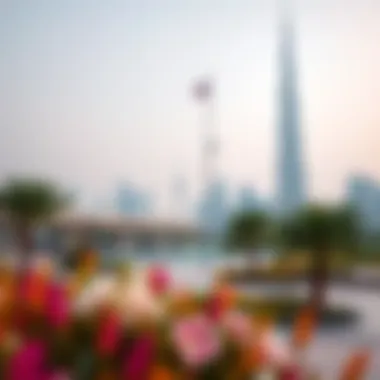

The experience visitors have at Burj Khalifa Park is crucial because it encapsulates the essence of this urban oasis. Not only is it about the view of the stunning Burj Khalifa, but also how people interact with the environment, engage in various recreational activities, and participate in the cultural life that flourishes within the park's borders. This unique experience provides insights into the broader significance of the park in Dubai's urban layout and contributes to the general enjoyment of all who visit.
Access and Amenities
When it comes to access, Burj Khalifa Park is designed with inclusivity in mind. The park is easily reachable from various points in Dubai, thanks to its strategic location near financial and leisure districts. Public transportation options such as Dubai Metro provide convenient access, while dedicated pedestrian pathways ensure that safety and ease of movement are prioritized. Ample parking spaces are available for those who prefer to drive.
Visitors will find an array of amenities catering to diverse interests and age groups. Well-maintained restrooms, drinking fountains, and picnic areas dotted throughout the park create a user-friendly environment. Wheelchair access is also a thoughtful consideration that promotes inclusiveness, allowing everyone to enjoy the lush landscapes and architectural marvels without barriers.
Overall, the amenities serve to enrich the visitor experience, turning a simple outing into a memorable day spent in nature and culture.
Cultural Events and Activities
Burj Khalifa Park is not merely a passive backdrop but a vibrant site for cultural exchange. The space often hosts seasonal events, outdoor exhibitions, and local festivals that highlight the rich heritage of Dubai and the UAE. For instance, traditional Emirati music performances and art displays often take place, giving visitors a tantalizing taste of local culture.
Moreover, the park frequently collaborates with community organizations to initiate workshops and educational programs. These events are designed to foster understanding about ecological sustainability, architectural significance, and the importance of preserving local flora and fauna. Participating in these activities can deepen the connection between visitors and the park, making their experience more fulfilling and enriching.
"Engaging with cultural events allows visitors to create lasting memories and a greater appreciation for the park's role in Dubai's urban identity."
The interplay of access, amenities, and cultural events transforms Burj Khalifa Park into a lively ecosystem. It invites both residents and visitors to explore, learn, and engage in a way that emphasizes the park’s significance in Dubai's urban tapestry.
Ecological Considerations
Understanding the ecological considerations of Burj Khalifa Park is crucial for appreciating its multifaceted role within Dubai’s urban ecosystem. Situated in the heart of one of the world’s fastest-growing cities, the park serves as a sanctuary of biodiversity, showcasing a well-thought-out balance between nature and urban development. This is not just about aesthetics; it's about fostering an environment that supports wildlife, promotes sustainability, and manages water efficiently.
Wildlife Support
Burj Khalifa Park is not merely an outdoor space, but a vital habitat that supports a variety of wildlife. Small urban parks can sometimes feel disconnected from larger ecosystems, yet right here, in the shadow of the tallest building in the world, one can witness countless birds, insects, and even small mammals thriving. This is a testament to careful planning that prioritizes biodiversity.
The selection of native plants serves dual purposes: they are well-adapted to the local climate and help sustain local wildlife. For example, the Arabian gazelle can sometimes be seen wandering near these lush green spaces, taking advantage of the cover and forage provided by the carefully curated flora. Moreover, these plants are low-maintenance, reducing the need for excessive watering and trimming, thereby aligning with sustainable practices.
Interestingly, the parks design integrates habitats that encourage species to flourish. Nesting boxes for birds, pollinator gardens, and designated areas for insects create small bubbles of biodiversity, serving not only as an environmental buffer but also enhancing the visitor experience. An urban park can be an oasis for wildlife if designed thoughtfully.
Water Management Strategies
Water management in a dry desert climate is a juggling act, and Burj Khalifa Park approaches this challenge with innovative strategies. The park's design incorporates systems that not only provide but also recycle water, crucial for maintaining its verdant landscapes. Efficient irrigation methods, like drip systems and smart use of gray water, ensure that resources are used sparingly and effectively.
This park takes inspiration from sustainable water practices; rainwater harvesting is a key component, allowing the park to collect and utilize natural precipitation, rather than solely relying on the municipal water supply. This sustainable technique not only minimizes impact on the local water table but also encourages the growth of flora.
Additionally, the park's water bodies—ponds and wetland areas—are not just for aesthetics. They play an important role in managing water runoff and supporting local wildlife. These bodies of water need to be well-maintained to prevent algal blooms and maintain ecological balance, which the park staff continuously monitors. This proactive approach not only enhances the visitor experience but also assures that the park remains a healthy environment for wildlife.
"A park that respects its ecological footprint can thrive amid urban development, creating a sanctuary for both nature and people."
In sum, ecological considerations at Burj Khalifa Park are not an afterthought but rather a foundational aspect that enriches its landscape and societal importance. For investors, realtors, and homebuyers, understanding these elements is essential, as they add intrinsic value to the properties nearby, enhancing liveability while showcasing environmental responsibility.
For further insights on urban biodiversity and water management techniques, check resources like Wikipedia, Britannica, and the City's official site.
Civic and Community Impact
Role in Urban Development
The Burj Khalifa Park plays a pivotal role in urban development in Dubai. The park is not merely a patch of greenery but serves as a catalyst for the surrounding area’s transformation. As the world’s tallest structure looms above, the park acts as a buffer, enhancing the overall aesthetic and functionality of the urban landscape.
This facility attracts both residents and tourists, providing a place where the hustle and bustle of city life melts away, if only for a moment. Apartments and offices in the vicinity see a marked increase in demand, owing to the park's consistent flow of foot traffic. Real estate developers recognize that their properties are more appealing when they overlook or are near this lush oasis, and they often leverage this proximity to boost property values.
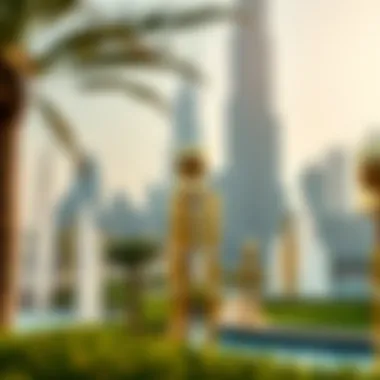

Moreover, the park encourages a sense of community. By offering venues for social gatherings and cultural events, it integrates seamlessly into the urban fabric. Public spaces like these encourage interaction among residents, fostering community ties that might otherwise fray in a bustling metropolis.
The Burj Khalifa Park is not just a park; it's a testament to how green spaces can elevate urban life.
Enhancing Local Real Estate
In addition to its role in urban development, Burj Khalifa Park substantially enhances local real estate markets. Its very presence serves as a significant draw for potential homebuyers and investors alike. Properties near the park tend to command higher prices, driven by the unique lifestyle that comes with living close to such a prominent locale.
- Investment Appeal: Investors often seek properties that promise long-term appreciation, and Burj Khalifa Park certainly fits that bill. The combination of residential and commercial opportunities surrounding the park makes it a prime target for new developments.
- Lifestyle Amenities: Homebuyers looking for a healthy, balanced lifestyle find immense value in proximity to green spaces. The park's walking paths, recreational activities, and natural beauty offer residents alternatives to urban living that they crave.
- Cultural Hub: The park frequently hosts events that celebrate the arts, food, and local culture, further enhancing its appeal. Properties situated near such vibrant atmospheres naturally see increased interest.
Hence, while investors are drawn to the potential financial gains, they also recognize the qualitative benefits of community and lifestyle that Burj Khalifa Park promotes. This dual influence solidifies the park’s role as a cornerstone in shaping not only the physical space but also the very essence of urban living in Dubai.
Navigating Real Estate Opportunities
In the vicinity of Burj Khalifa Park, real estate opportunities are flourishing, presenting a unique blend of nature and urban living. The park not only enhances the aesthetic appeal of the area, but it also creates a vibrant community that attracts investors, future homeowners, and tenants alike. This section will delve into the importance of understanding real estate dynamics surrounding the park, highlighting the factors that make it an attractive destination for various stakeholders in the property market.
Residential Developments Nearby
Residential developments adjacent to Burj Khalifa Park showcase a range of options from luxury apartments to affordable housing, each boasting proximity to green spaces enhanced by the park’s lush landscapes. Notably, projects like the The Address Residence Fountain Views and The Silkhaus offer modern living with views overlooking the park, making them highly sought after. The blend of expansive leisure spaces and residential zoning creates a lifestyle that is both tranquil and dynamic.
- Key Attributes of Nearby Residential Developments:
- Close distance to key amenities like shopping centers and restaurants.
- Easy access to major transportation networks, reducing commuting times.
- Architectural designs that reflect modern aesthetics while incorporating sustainable features.
- Community-driven spaces that foster belonging and interaction.
With the ongoing development activities and the government’s investment in infrastructure, these residential offerings are about more than just a place to live; they are gateways to an upgraded urban lifestyle, attracting diverse demographics ranging from young professionals to families.
Investment Potential
Investing in real estate near Burj Khalifa Park is not merely a matter of purchasing property; it is a strategic move embedded with potential benefits. The ongoing urbanization efforts in Dubai and international interest in the area make it a hotbed for real estate growth.
"Strategically located properties tend to appreciate faster, especially those that benefit from unique locations, like access to nature and key attractions."
- Factors Influencing Investment Potential:
- Increasing tourism rates, which draw visitors to properties in the vicinity for short-term leasing opportunities.
- Emergence of a global economic hub in Dubai, continuing to bolster demand for housing.
- Expected infrastructural improvements including transportation enhancements such as the Dubai Metro expansions.
- Rising interest from expatriates and foreign investors looking for stable growth.
Investors should look closely at market trends, as the synergy between residential investments and the park’s cultural significance positions the area for long-term value appreciation. Real estate surrounding the Burj Khalifa Park not only serves a functional purpose but acts as a luminous investment beacon, promising returns driven by both lifestyle allure and effective urban planning.
As the property market continues to evolve, understanding these elements can provide an edge to those looking to navigate the competitive landscape effectively.
Ending
In reflecting on the role of Burj Khalifa Park, it becomes evident that its contribution extends beyond mere aesthetics or recreational use. This park stands as a vital soul in Dubai's urban fabric, merging nature and architecture seamlessly while enhancing the city's liveliness. The significance of such a park cannot be understated, especially as it pertains to urban living. It provides a necessary respite from the bustling city routine, offering an essential breathing space where city dwellers can reconnect with nature.
Summary of Key Insights
The exploration of Burj Khalifa Park has unveiled multiple layers of insights worth noting. Firstly, the park's architectural features showcase a harmonious design that reflects the grandeur of the Burj Khalifa. Secondly, the landscaping, particularly the selection of native plants, reinforces sustainability practices, emphasizing Dubai's commitment to environmental consciousness. Notably, the park serves not just local residents but draws visitors from around the globe, fostering cultural exchange through numerous events and activities. The park also plays a pivotal role in enhancing local property values, highlighting its importance as a community and economic asset.
- Architectural Brilliance: The design elements resonate with the overall theme of magnificence observed in the Burj Khalifa.
- Sustainable Choices: Native plant species not only beautify the space but promote ecological harmony.
- Cultural Vibrancy: Events held at the park are magnets for fostering community spirit and cultural exchange.
- Economic Reinforcement: Increased property values nearby reflect the park's significant contribution to local real estate.
Future Developments in the Area
Looking ahead, the potential for Burj Khalifa Park and its surrounding area is substantial. With the steady influx of tourists and the ongoing urban development projects in Dubai, further enhancements to the park's facilities are highly probable. Plans are in the pipeline to introduce more interactive features and ecological educational programs aimed at fostering awareness about environmental issues.
Moreover, investments in local commerce are also likely to see a boost. The park’s attractions could lead to more dining and retail options being developed, providing not only convenience for visitors but also stimulating local businesses.
- Interactive Features: New installations and activities aimed at engaging families.
- Ecotourism Initiatives: Programs to educate visitors about the local ecosystem could strengthen environmental stewardship.
- Increased Local Commerce: New ventures around the park aimed at catering to both residents and tourists.
"The Burj Khalifa Park is not just a park; it's an emblem of Dubai's commitment to sustainability, culture, and community."
